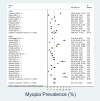Prevalence of myopia in Indian school children: Meta-analysis of last four decades
- PMID: 33075102
- PMCID: PMC7571694
- DOI: 10.1371/journal.pone.0240750
Prevalence of myopia in Indian school children: Meta-analysis of last four decades
Abstract
Background: India is the second most populated country in the world with 41% of the population (492 million) under 18 years of age. While numerous studies have shown an increasing prevalence of myopia worldwide, there continues to be uncertainty about the magnitude of myopia in Indian school going population.
Design: Systematic review and meta-analysis.
Methods: We systematically identified published literature of last four decades from 1980 to March 2020 and assessed them for methodological quality. Data were gathered into 5-year age groups from 5-15, in urban or rural populations, and standardized to definition of myopia as refractive error ≥ -0.50 dioptre. Random effects meta-analysis was done.
Results: We included data from 59 quality assessed studies, covering nearly 1,66,000 urban and 1,20,000 rural children. The overall crude prevalence of myopia over last four decades is 7.5% (95% CI, 6.5-8.5%) in 5-15-year age group. The prevalence of myopia is 8.5% (95% CI, 7.1-9.9%) in urban and 6.1% (95% CI, 4.5-7.7%) in rural children, with highest prevalence in urban 11-15-year age group [15.0% in last decade]. A significant increment in prevalence is noted in the last decade in rural children from 4.6% to 6.8%, reflecting changing rural environment.
Conclusion: Myopia is an emerging public health problem in both urban and rural school going adolescents in India requiring urgent efforts.
Conflict of interest statement
The authors have declared that no competing interests exist.
Figures




References
-
- Saw S-M, Pan CW, Dirani M, Cheng C-Y, Wong TY. Is myopia more common in Asians? A systematic review and meta-analysis. Invest Ophthalmol Vis Sci. 2014. April 30;55(13):3632–3632.
-
- Census of India: age structure and marital status. [cited 2020 Mar 10]. Available from: http://censusindia.gov.in/Census_And_You/age_structure_and_marital_statu...
Publication types
MeSH terms
LinkOut - more resources
Full Text Sources

